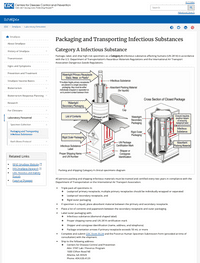Packaging and Transporting Infectious Substances: Category A (UN 2814) and Category B (UN 3373)
[Packaging and Transporting Infectious Substances]
This page describes the packaging regulations that Category A and Category B infectious substances are subject to according to the U.S. Department of Transportation’s Hazardous Materials Regulations and the International Air Transport Association (IATA) Dangerous Goods Regulations. It includes diagrams of the proper packaging.
SUMMARY
The Packaging and Transporting Infectious Substances page describes the packaging regulations that Category A (UN 2814) and Category B (UN 3373) infectious substances are subject to according to the United States Department of Transportation’s Hazardous Materials Regulations and the International Air Transport Association (IATA) Dangerous Goods Regulations. The page is published by the US Centers for Disease Control and Prevention, and while some regulations may be US specific, these regulations provide an example of how to safely transport infectious substances.
The transportation categories come from the United Nations Recommendations on the Transport of Dangerous Goods, which is also known as the Orange Book. The book describes the UN packing code system, a way of marking packages so that shippers are able to identify which dangerous material is being shipped and what safety precautions must be in place. Category A covers high-risk infectious materials affecting humans, and Category B covers low- or moderate-risk specimens.


..png)
